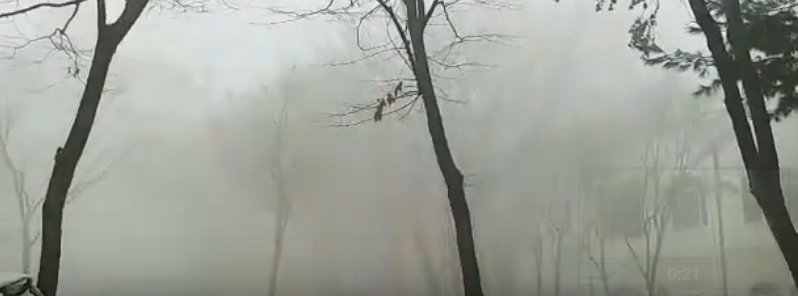Yellow dust storm descends on South Korea

A yellow dust storm has hit South Korea for the first time this season, with Seoul's PM10 over 220 micrograms per cubic meter early morning on October 29, 2019. This is over four times the level considered safe.
According to the World Health Organization (WHO), PM10 is carcinogenic as these particles can travel through the respiratory tract into the bloodstream, which may cause stroke, heart ailments, or even lung cancer.
"With the southeastern movement of the yellow dust across the peninsula, we expect high levels of PM10 throughout the country for the day," said Air Korea, the Ministry of Environment's air quality monitoring agency.
The dust combines with emissions from factories in the northeastern coastal areas of China and local sources such as vehicle emissions and coal power plants, the agency further explained.
This situation reportedly gets worse every year.

Yellow dust is known to carry more PM10 than PM2.5 articles, which have diameters less than 2.5 micrometers. This pose greater risk to humans.
The Seoul Metropolitan Government's Climate and Environment Headquarters said this is particularly so at the time when yellow dust is returning into Korea.
WHO recommends exposure not greater than 50 micrograms of PM10 on a daily average, and 25 micrograms of PM2.5.
At 04:00 LT on October 29, the PM10 level has hit 228 micrograms in the district of Yangcheon, western Seoul.
By 14:00 LT, the level has settled down to 143 micrograms.
High levels of PM10 in the early morning hours also hit other areas of Seoul: 208 micrograms in Seocho District, southern Seoul; 159 micrograms in Gwangjin District, eastern Seoul; and 92 micrograms in Eunpyeong District, northern Seoul.
In the afternoon, the level has settled down to around 95 to 110 micrograms.
The hourly average of PM10 outside of Seoul remained high through the afternoon: 173 micrograms in Busan, 213 micrograms in Daegu; 131 micrograms in Gwangju; 243 micrograms in Ulsan; 121 micrograms in Gyeonggi; 162 micrograms in South Jeolla; 228 micrograms in South Gyeongsang; and 215 micrograms in Jeju.
However, the hourly average of PM2.5 remained below WHO's recommended level of 25 micrograms in at least 12 cities throughout South Korea.
Yellow Dust reaching Korea pic.twitter.com/hiNaMHfP1Z
— JPR007 (@jpr007) September 30, 2019
At 15:00 LT, the PM2.5 level was 18 micrograms in Seoul; 13 micrograms in Incheon; 15 micrograms in Gyeonggi; 9 micrograms in Sejong; 18 micrograms in Daejeon; 13 micrograms in South Chungcheong; and 16 micrograms in North Jeolla.
Further in the afternoon, several southern cities experienced high PM2.5 levels namely Busan, with an hourly average of 45 micrograms, and Ulsan with 55 micrograms.
Following the high PM10 levels in the morning, officials have issued a fine dust warning and urged people to wear masks.
People with respiratory problems are advised to stay at home as much as possible.
"We expect the air quality to improve by tomorrow [October 30], as atmospheric movements remain active," Air Korea stated.
Korea is hit with yellow dust every winter, which is between November to early March, and every spring, which is from March to May. The dust comes from the Gobi desert, which covers parts of northern China and southern Mongolia.
Featured image credit: Hannul Han Korea/YouTube

Commenting rules and guidelines
We value the thoughts and opinions of our readers and welcome healthy discussions on our website. In order to maintain a respectful and positive community, we ask that all commenters follow these rules.